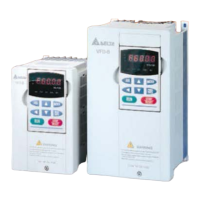Chapter 12 Descriptions of Parameter SettingsC2000 Plus
12.1-07-14
The prerequisites for invalid automatic energy-saving optimization (Pr.07-21=2) are:
1. A changing output frequency
2. The loss model automatically determines the voltage drops when the drive is in normal
and heavy duty. If there is no more voltage that can be adjusted, that is, the voltage drop
is already optimized, AES is invalid.
The energy-saving function is invalid during the drive’s acceleration and deceleration. To make it
valid, the prerequisites need to be verified again.
07-23
Automatic Voltage Regulation (AVR) Function
Default: 0
Settings
0: Enable AVR
1: Disable AVR
2: Disable AVR during deceleration
The rated voltage of the motor is usually 200–240 V
AC
(380–480 V
AC
), 60 Hz / 50 Hz and the input
voltage of the AC motor drive may vary between 170–264 V
AC
(323–528 V
AC
), 50 Hz / 60 Hz.
Therefore, when the AC motor drive is used without the AVR function, the output voltage is the
same as the input voltage. When the motor runs at the voltage exceeding 12–20% of the rated
voltage, it causes higher temperature, damaged insulation, and unstable torque output, which
result in losses due to shorter motor lifetime.
The AVR function automatically regulates the output voltage of the AC motor drive to the motor’s
rated voltage when the input voltage exceeds the motor’s rated voltage. For example, if the V/F
curve is set at 200 V
AC
/ 50 Hz and the input voltage is at 200–264 V
AC
, then the drive automatically
reduces the output voltage to the motor to a maximum of 200 V
AC
/ 50 Hz. If the input voltage is at
170–200 V
AC
, the output voltage to motor is in direct proportion to the input voltage.
0: When the AVR function is enabled, the drive calculates the output voltage according to the
actual DC bus voltage. The output voltage does NOT change when the DC bus voltage changes.
1: When the AVR function is disabled, the drive calculates the output voltage according to the
actual DC bus voltage. The output voltage changes with the DC bus voltage, and may cause
insufficient current, over-current or oscillation.

